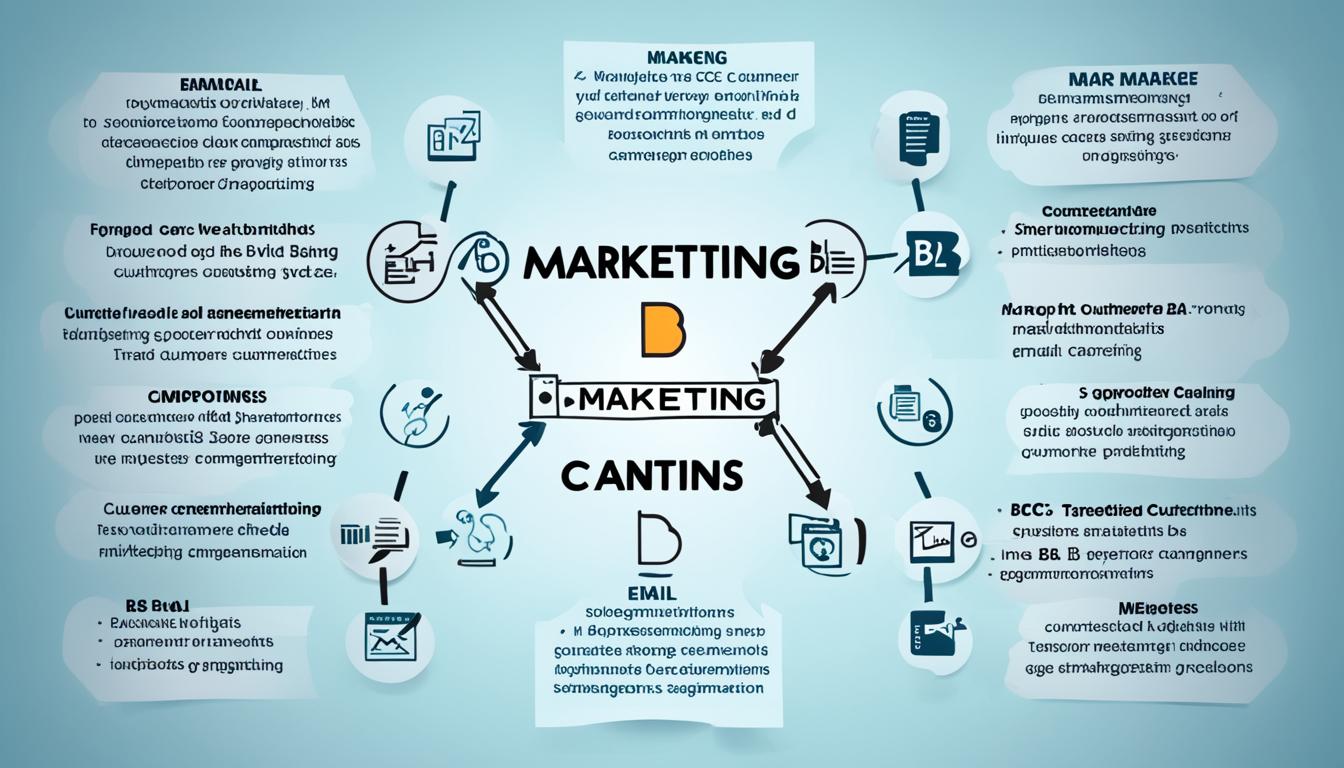In the world of digital marketing, two key strategies stand out: commercial marketing and social marketing. While both approaches aim to promote products or services, they differ significantly in their goals, target audience, and strategies. Understanding the differences between commercial marketing and social marketing is crucial for businesses to develop effective marketing strategies and achieve their desired outcomes.
Commercial marketing primarily focuses on driving sales and generating profits. Businesses use various digital marketing techniques, such as branding and social media advertising, to influence consumers’ purchasing decisions and enhance their market share. The primary goal of commercial marketing is to fulfill customers’ needs and wants and maximize revenue for the company.
On the other hand, social marketing takes a more holistic approach. This long-term marketing strategy aims to bring about social change and improve society and the environment. Social marketing focuses on using promotional methods to alter human behavior and address global problems. It aims to evoke consciousness, change behavior, and improve lives.
The differences between commercial marketing and social marketing go beyond their purposes. They also differ in their target audience and benefits. Commercial marketing typically targets consumers who have purchasing power, whereas social marketing has a broader target audience, which includes individuals, communities, and even governments. Social marketing often serves non-profit social organizations and government agencies, while commercial marketing is used by for-profit business organizations.
Now that we have a basic understanding of the differences between commercial marketing and social marketing, let’s explore their definitions, purposes, and strategies in more detail. By delving into each approach, we can gain valuable insights into how businesses can effectively leverage these marketing strategies to achieve their goals and make a positive impact on society.
Key Takeaways:
- Commercial marketing focuses on driving sales and generating profits, while social marketing aims to bring about social change and improve society and the environment.
- Commercial marketing targets consumers with purchasing power, while social marketing has a broader target audience that includes individuals, communities, and governments.
- Commercial marketing uses branding and social media advertising to influence purchasing decisions, while social marketing applies marketing techniques to drive behavioral change.
- Understanding the differences between commercial marketing and social marketing is crucial for businesses to develop effective marketing strategies and achieve their desired outcomes.
- By leveraging commercial marketing and social marketing strategies, businesses can maximize their revenue while making a positive impact on society.
Definition and Purpose of Social Marketing
Social marketing applies commercial marketing principles to drive behavioral change for the betterment of society and the environment. Unlike traditional marketing, which focuses on sales and brand awareness, social marketing aims to promote positive social change by influencing attitudes and behaviors. The purpose of social marketing is to bring about benefits for the general public and address societal and environmental issues.
Key Elements of Social Marketing
Social marketing involves several key elements that differentiate it from other forms of marketing:
- Behavior Change: Social marketing aims to inspire and encourage individuals to adopt new behaviors that contribute to positive societal outcomes, such as recycling, reducing energy consumption, or quitting smoking.
- Audience-Centric Approach: Social marketing carefully identifies and understands its target audience, tailoring messages and strategies to resonate with individuals and motivate them to take action.
- Positive Social Change: The ultimate goal of social marketing is to create positive social change by addressing issues such as public health, environmental sustainability, and social justice.
- Research and Evaluation: Social marketing relies on research and evaluation to assess the effectiveness of campaigns and make data-driven decisions. This ensures that resources are utilized efficiently to achieve desired behavior change.
By utilizing these key elements, social marketing campaigns can have a significant impact on individuals and society as a whole, leading to lasting positive change. These campaigns can tackle a wide range of issues, including public health, environmental conservation, poverty alleviation, and more.
Example of Social Marketing in Action: The “Don’t Drink and Drive” Campaign
An example of a successful social marketing campaign is the “Don’t Drink and Drive” campaign. This campaign aims to reduce alcohol-related accidents and fatalities by encouraging people to designate a sober driver or use alternative transportation options after consuming alcohol.
Through compelling messages, impactful visuals, and targeted outreach, the campaign highlights the dangers of drunk driving and promotes responsible behavior choices. It leverages various communication channels, such as television advertisements, social media campaigns, and community events, to reach a wide audience and influence behavior change.
| Key Components | Outcome |
|---|---|
| Public awareness campaigns | Increased awareness about the dangers of drunk driving |
| Partnerships with ride-sharing services | Encouraged use of alternative transportation options |
| Community events and workshops | Provided education and resources for responsible alcohol consumption |
This example demonstrates how social marketing can effectively promote behavior change and contribute to positive social outcomes. By combining targeted messaging, strategic partnerships, and community engagement, social marketing campaigns have the power to influence attitudes, shape behaviors, and create a safer and more sustainable society.
Definition and Purpose of Commercial Marketing
Commercial marketing encompasses the various strategies and techniques deployed to satisfy customers’ needs and desires while achieving profitability for businesses. The driving force behind commercial marketing is to generate sales and maximize profits by influencing customers’ purchasing decisions.
The purpose of commercial marketing is twofold:
- Driving Sales: Commercial marketing aims to promote products or services in a way that entices customers to make a purchase. It involves creating awareness about the brand, portraying its value proposition, and persuading customers to choose one product over others in the market. By effectively targeting and engaging the intended audience, commercial marketing endeavors to increase sales and expand the customer base.
- Generating Profits: Alongside driving sales, commercial marketing plays a crucial role in generating profits for businesses. By strategically pricing products, controlling costs, and managing resources, commercial marketing aims to optimize revenue and ensure a healthy bottom line. Profitability allows businesses to invest in growth, innovation, and further marketing efforts, strengthening their competitive edge in the market.
Commercial marketing is an integral part of a company’s overall marketing strategy, as it drives revenue and sustains the organization’s financial health.
The Purpose of Commercial Marketing
| Objective | Description |
|---|---|
| Driving Sales | Influencing customers’ purchasing decisions, increasing product demand, and boosting sales revenue. |
| Generating Profits | Optimizing revenue, managing costs, and maximizing profitability for sustainable business growth. |
Source: Own elaboration.
Key Differences Between Social Marketing and Commercial Marketing
When it comes to marketing strategies, social marketing and commercial marketing serve different purposes and target distinct audiences. Understanding the key differences between these two approaches is essential for businesses and organizations looking to achieve their marketing goals effectively.
Purpose
Social marketing aims to bring about positive social change by addressing societal and environmental issues. Its purpose extends beyond driving sales and generating profits, focusing instead on promoting behaviors that benefit society as a whole. On the other hand, commercial marketing is primarily concerned with driving sales and generating profits for for-profit business organizations.
Target Audience
Social marketing has a broader target audience, as it is often used by non-profit social organizations and government agencies. These campaigns aim to engage the general public and encourage behavior change that leads to positive social outcomes. In contrast, commercial marketing primarily targets potential customers and aims to influence their purchasing decisions.
Benefits
The benefits of social marketing lie in the positive impact it creates for society and the environment. By addressing societal issues and promoting behavior change, social marketing campaigns contribute to the betterment of communities and the world. Commercial marketing, on the other hand, seeks to benefit businesses by driving sales and generating profits.
Users
Users of social marketing include non-profit organizations, government agencies, and other entities focused on social and environmental causes. These users leverage social marketing strategies to raise awareness, drive behavior change, and achieve positive social outcomes. On the contrary, for-profit business organizations are the primary users of commercial marketing strategies, aiming to increase their market share and profitability.
By understanding these key differences, businesses and organizations can effectively choose the right marketing approach to fulfill their goals and engage with the appropriate target audience. Whether it is driving sales or driving positive social change, each strategy has its unique benefits and implications.
Social Marketing Strategies and Tips
When it comes to social marketing, implementing effective strategies is key to achieving the desired behavior change and making a positive impact on society. Here are some essential tips to help you create successful social marketing campaigns:
- Conduct Audience Research: Before launching your campaign, take the time to understand your target audience. Conduct thorough research to gain insights into their demographics, motivations, and preferences. This will allow you to tailor your messaging and tactics accordingly.
- Be Convincing: To influence behavior, your messaging needs to be persuasive and compelling. Use evidence-based arguments and emotional appeals to convince your audience of the benefits and importance of the desired behavior change.
- Choose Catchy Slogans: A catchy slogan can capture attention and make your campaign memorable. Craft slogans that are succinct, impactful, and resonate with your target audience. A well-chosen slogan can become the rallying cry for your cause.
- Use Visuals Wisely: Visuals are powerful tools in social marketing. They can help illustrate the problem and its consequences, evoke emotions, and inspire action. Utilize impactful images, infographics, and videos to deliver your message effectively.
- Influence Behavior: Employ behavior change techniques to nudge your audience towards adopting the desired behavior. Use social norms, incentives, and prompts to encourage positive actions. Make it easy and convenient for your audience to engage in the desired behavior.
Remember, it is essential to focus on one audience and behavior at a time. This allows for a targeted and tailored approach to achieve the desired social change. Study different behaviors in various contexts to gather insights and adapt your strategies accordingly.
By implementing these strategies and tips, you can create impactful social marketing campaigns that effectively influence behavior and drive positive social change.
https://www.youtube.com/watch?v=iu8dU7mVDDk
Examples of Social Marketing Campaigns
Social marketing campaigns play a crucial role in promoting sustainability and driving social change. Let’s take a look at two successful examples:
Friends of the Earth
Friends of the Earth is a well-known environmental organization that aims to make different areas climate-friendly, fight for social justice, and protect nature. Their social marketing campaigns focus on raising awareness about environmental issues and encouraging individuals, communities, and policymakers to take action. Through targeted messaging and strategic campaigns, Friends of the Earth promotes sustainable practices, raises funds for environmental causes, and drives positive change.
Tips From Former Smokers Campaign
The Tips From Former Smokers Campaign, initiated by the Centers for Disease Control and Prevention (CDC), is a powerful social marketing campaign targeted at reducing tobacco use and its associated health risks. This campaign showcases the real stories and health consequences of smoking through compelling visuals, personal narratives, and testimonials from former smokers. By highlighting the negative impact of smoking on individuals and their loved ones, the campaign aims to motivate smokers to quit and discourage non-smokers from starting.
These examples demonstrate how social marketing campaigns can effectively address pressing issues, create awareness, and drive social change. By leveraging persuasive messaging, impactful visuals, and targeted strategies, these campaigns propel individuals and society towards a more sustainable and responsible future.
| Campaign Name | Organization | Aim |
|---|---|---|
| Friends of the Earth | Environmental organization | To make different areas climate-friendly, fight for social justice, and protect nature |
| Tips From Former Smokers Campaign | Centers for Disease Control and Prevention (CDC) | To reduce tobacco use and showcase the health issues caused by smoking |
The Role of Social Marketing in Today’s Business Environment
In today’s digital business environment, the role of social marketing is more crucial than ever. Social marketing goes beyond traditional marketing strategies to enhance brand image and credibility. It allows businesses to effectively engage with their audience, build trust, and establish a strong presence in the market.
When businesses demonstrate their commitment to social responsibility through their marketing efforts, it sets them apart from their competitors. Customers are increasingly conscious of the social impact of the brands they support, and they are more likely to trust and align themselves with businesses that prioritize societal well-being.
Social marketing has the power to drive large-scale societal change. By leveraging social media platforms and other digital channels, businesses can spread critical messages and influence behavior on a global scale. This ability to connect with a wide audience and inspire action is unique to social marketing.
Moreover, social marketing enhances customer loyalty. When businesses engage in socially responsible practices and advocate for positive change, they foster a deep sense of loyalty among their customers. Customers develop an emotional connection with brands that align with their values and actively contribute to making a difference in society.
In conclusion, social marketing plays a pivotal role in today’s business environment. It not only enhances brand image and credibility but also drives societal change and cultivates customer loyalty. By integrating social marketing strategies into their overall marketing efforts, businesses can not only achieve commercial success but also make a positive impact on the world around them.

Advantages of Social Marketing: Reach and Engagement
Social marketing offers numerous advantages for businesses, providing unparalleled reach and engagement opportunities. With its ability to connect with large audiences, social marketing enables businesses to establish direct connections with their customers, fostering brand loyalty and driving customer engagement.
One of the key advantages of social marketing is its reach. Through social media platforms, businesses can reach a broad audience, including individuals from various demographics and geographic locations. The large user base of platforms like Facebook, Instagram, and Twitter provides businesses with the potential to expose their brand to millions of users.
This wide reach also creates a “ripple effect,” as engaged users share content, expanding the brand’s visibility even further. When content resonates with users and goes viral, it can reach an exponentially larger audience, generating a significant impact on brand awareness and recognition.
Furthermore, social marketing allows for two-way interaction between businesses and their customers. This direct connection enables businesses to deliver personalized content, tailoring their messaging to specific segments of their audience. By understanding their customers’ preferences and interests, businesses can create targeted campaigns that resonate, increasing the likelihood of engagement and conversion.
The engagement aspect of social marketing is another significant advantage. When users interact with content, such as liking, commenting, or sharing posts, they actively engage with the brand, presenting an opportunity for businesses to build relationships and foster loyalty. Social media provides an ideal platform for customer service as well, allowing businesses to respond promptly to inquiries and provide support, enhancing the overall customer experience.
Advantages of Social Marketing
The main advantages of social marketing can be summarized as follows:
- Unparalleled reach and exposure to large audiences.
- A platform for creating a ripple effect and increasing brand visibility.
- Direct connection with customers, enabling personalized content delivery.
- Improved customer service and engagement opportunities.
- Fostering brand loyalty and long-term customer relationships.
Example Table: Social Media Platforms Comparison
| Monthly Active Users (Millions) | Engagement Rate | Target Audience | |
|---|---|---|---|
| 2,900 | 5% | General audience, diverse demographics | |
| 1,200 | 15% | Youth and young adults, visual content enthusiasts | |
| 330 | 5% | News, entertainment, and tech-savvy audience |
By leveraging the advantages of social marketing, businesses can tap into the vast potential of social media platforms to reach a broad audience, engage customers, and create meaningful connections. This form of marketing allows businesses to go beyond traditional advertising methods by establishing authentic relationships with their target audience, driving brand awareness, and ultimately contributing to their long-term success.
Conclusion
The importance of social marketing cannot be overstated in today’s business landscape. While commercial marketing focuses on driving sales and generating profits, social marketing goes beyond financial gains and aims to drive social change and bring about benefits for society as a whole. Both strategies play a crucial role in marketing, but they serve different goals and target different audiences.
Commercial marketing is primarily concerned with the bottom line, aiming to influence customer purchasing decisions and maximize revenue. On the other hand, social marketing focuses on promoting positive social change, addressing societal and environmental issues, and improving the lives of individuals and communities.
Understanding the differences between social marketing and commercial marketing is vital for businesses and organizations to implement effective marketing strategies. By recognizing the unique goals and target audiences of each approach, marketers can tailor their campaigns and messaging to achieve the desired outcomes. Whether the objective is driving sales or driving social change, a thoughtful and strategic approach will ultimately lead to success.
In conclusion, both social marketing and commercial marketing have their place in the marketing landscape. By harnessing the power of both strategies, businesses can not only drive profits but also contribute to positive societal change and build stronger connections with their audiences.
FAQ
What is the difference between commercial marketing and social marketing?
Commercial marketing focuses on driving sales and generating profits, while social marketing aims to bring about positive social change.
What is the purpose of social marketing?
The purpose of social marketing is to address societal and environmental issues by promoting behavior change and improving people’s lives.
What is the purpose of commercial marketing?
Commercial marketing aims to fulfill customers’ needs and wants in a profitable way, driving sales and generating profits for the company.
Who uses social marketing?
Social marketing is often used by non-profit social organizations and government agencies to promote positive social change.
Who uses commercial marketing?
Commercial marketing is used by for-profit business organizations to drive sales and generate profits.
What are some effective social marketing strategies?
Effective social marketing strategies include conducting research on the target audience, using convincing messaging, choosing catchy slogans, using visuals to demonstrate the problem, and using behavior change techniques.
Can you provide examples of successful social marketing campaigns?
Friends of the Earth, which aims to make areas climate-friendly and protect nature, and the Tips From Former Smokers Campaign, which focuses on health issues caused by smoking, are examples of successful social marketing campaigns.
What is the role of social marketing in today’s business environment?
Social marketing plays a crucial role in enhancing brand image and credibility, connecting with large audiences, and driving societal change through critical messages and behavior influence.
What are the advantages of social marketing?
Social marketing allows for unparalleled reach and engagement opportunities, enabling businesses to connect with large audiences and establish direct connections with customers for increased brand visibility, personalized content delivery, and improved customer loyalty.
What is the difference between social marketing and commercial marketing?
While commercial marketing focuses on driving sales and generating profits, social marketing aims to drive social change and bring about benefits for society as a whole.




